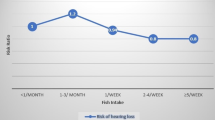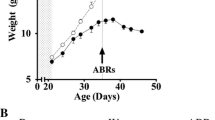Abstract
The cochleae of animals contain large quantities of taurine1 but its function there remains uncertain3, 15. It is well established that taurine levels of most organs are high at birth and decrease slowly during maturation but little is known about the clinical significance of this. Tyson et al. 13 suggest that dietary taurine levels influence hearing development in pre-term infants but whether this data justifies the routine supplementation of baby food is somewhat contentious10, 14. Nevertheless, most baby milk powders are now supplemented with taurine at 30–40 mg/100 g. However, the decision to make this supplementation has been made on rather less than conclusive evidence. The major argument for supplementation is that human milk contains substantial quantities of taurine11. There are also a number of animal studies that indicate its essentiality, certainly in some species. There is little doubt that taurine is an essential dietary component in some species such as cat4, 12 and the evidence that taurine is essential for good development and function of the retina in monkey is substantial6, 9. The evidence gathered from studies on babies, however, is much more equivocal. Studies on pre-term babies13 and babies receiving long-term parenteral nutrition2 suggest that taurine might be essential for good sensory development. Tyson et al. 13 used the auditory brain stem-evoked response (ABER) and electro-retinograms to monitor the development of their subjects and although they found no difference in the retinograms of babies fed the different diets, some differences in the ABERs were noted. Michalk et al. 8 were unable to detect any differences in the nervous or cardiovascular systems of term babies fed taurine-supplemented diets. Little further data are available on the influence of taurine on the development of normal babies.
Access this chapter
Tax calculation will be finalised at checkout
Purchases are for personal use only
Preview
Unable to display preview. Download preview PDF.
Similar content being viewed by others
References
Davies, W.E. and Owen, C. 1985, The nature of neurotransmitters in the mammalian lower auditory system, in: “Auditory biochemistry”, Drescher, D.G. ed., Thomas, Springfield, IL, pp. 244–257.
Geggel, H.S., Ament, M., Heckenlively, J.R., Martin, D.A., and Kopple, J.D. 1985, Nutritional requirement for taurine in patients receiving long-term parenteral nutrition, N.Engl.J.Med. 312:142–146.
Harding, N.J. and Davies, W.E. 1993, Cellular localisation of taurine in the organ of Corti, Hearing Res. 65:211–215.
Hayes, K.C., Carey, R.E., and Schmidt, S.Y. 1985, Retinal degeneration associated with taurine deficiency in the cat, Nutr.Rev. 43:84–86.
Hopkins, P.C., Kay, I.S., and Davies, W.E. 1989, A rapid method for the determination of taurine in biological tissue, Neurochem.International, 15:429–432.
Imaki, H., Moretz, R., Wisniewski, H., Neuringer, M., and Sturman, J. 1987, Retinal degeneration in three-month-old rhesus monkey infants fed a taurine-free human infant formula, J.Neurosci.Res. 18:602–614.
Irving, C.S., Marks, L., Klein, P.D., Foster, N., Gadde, P.L., Chase, T.N., and Samuel, D. 1986, New evidence for taurine biosynthesis in man obtained from 18O2 inhalation studies, Life Sci. 38:491–495.
Michalk, D., Ringeisen, R., Tittor, F., Lauffer, H., Deeg, K., and Böhles, H. 1988, Development of the nervous and cardiovascular systems in low-birth-weight infants fed a taurine-supplemented formula, Eur.J.Pediat. 147:296–299.
Neuringer, M., Sturman, J.A., Wen, G.Y., and Wisniewski, H.M. 1985, Dietary taurine is necessary for normal retinal development in monkeys, in: “Taurine: biological actions and clinical perspectives”, Oja, S.S., Ahtee, L., Kontro, P. and Paasonen, M.K. eds., Alan R. Liss, New York, pp. 53–62.
Perlman, M. 1989, Taurine and auditory system maturation, Pediatrics, 83:796–798.
Rassin, D.K., Sturman, J.A., and Gaull, G.E. 1978, Taurine and other free amino acids in milk of man and other mammals, Early Human Devel. 2:1–13.
Sturman, J.A. 1993, Taurine in development, Physiol.Rev. 73:119–147.
Tyson, J.E., Lasky, R., Flood, D., Mize, C., Picone, T., and Paule, C.L. 1989, Randomized trial of taurine supplementation for infants ≤ 1, 300-gram birth weight: Effect on auditory brainstem-evoked responses, Pediatrics, 83:406–415.
Tyson, J.E., Mize, C., and Lasky, R. 1989, More on taurine, Pediatrics, 83:1072–1073.
Usami, S. and Ottersen, O.P. 1995, The localization of taurine-like immunoreactivity in the organ of Corti: A semiquantitative, post-embedding immuno-electron microscopic analysis in the rat with some observations in the guinea pig, Brain Res. 676:277–284.
Van Gelder, N.M. and Bélanger, F. 1988, Embryonic exposure to high taurine: A possible nutritional contribution to Friedreich’s ataxia, J.Neurosci.Res. 20:383–389.
Author information
Authors and Affiliations
Editor information
Editors and Affiliations
Rights and permissions
Copyright information
© 1996 Springer Science+Business Media New York
About this chapter
Cite this chapter
Davies, W.E., Hopkins, P.C., Rose, S.J., Dhillon, S.K. (1996). The Influence of Different Taurine Diets on Hearing Development in Normal Babies. In: Huxtable, R.J., Azuma, J., Kuriyama, K., Nakagawa, M., Baba, A. (eds) Taurine 2. Advances in Experimental Medicine and Biology, vol 403. Springer, Boston, MA. https://doi.org/10.1007/978-1-4899-0182-8_70
Download citation
DOI: https://doi.org/10.1007/978-1-4899-0182-8_70
Publisher Name: Springer, Boston, MA
Print ISBN: 978-1-4899-0184-2
Online ISBN: 978-1-4899-0182-8
eBook Packages: Springer Book Archive




